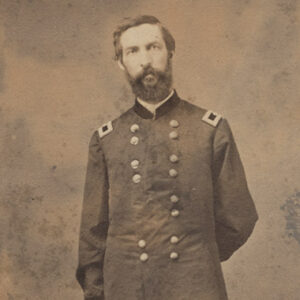calsfoundation@cals.org
Christopher Columbus Andrews (1829–1923)
As a Union brigadier general, Christopher Columbus Andrews distinguished himself in numerous military campaigns in Arkansas. After the Civil War, he had a successful career as an author and diplomat.
Born in Hillsborough, New Hampshire, on October 27, 1829, to Luther Andrews and Nabby Beard Andrews, Christopher Columbus Andrews attended Francestown Academy and studied law both privately and at Harvard University. Andrews passed the Massachusetts bar examination in 1850 and, soon thereafter, migrated to Kansas Territory, where he advocated for Kansas’s admission as a free state.
Andrews moved to Minnesota in 1856, where he established a law practice and published a series of letters based on his travels throughout the territory. He discussed the area’s Native American culture and championed its potential for economic and political development. In 1859, he won election to the state Senate as a Democrat. During the 1860 election, he supported Stephen A. Douglas and was nominated as a presidential elector for Minnesota. In 1861, Andrews operated the Minnesota Union newspaper, which supported the incoming administration of Abraham Lincoln.
At the start of the Civil War, Andrews initially enlisted as a private in the Third Minnesota Infantry but quickly earned promotion to captain of Company I. Captured along with most of the regiment at Murfreesboro, Tennessee, on July 15, 1862, Andrews was exchanged in October. In the subsequent regimental reorganization, Andrews earned promotion to lieutenant colonel and served throughout the Vicksburg Campaign. For services at Vicksburg, Mississippi, he was promoted to colonel on July 15, 1863, and subsequently commanded a brigade during the Little Rock Campaign. Despite a bout with malaria, he served as post commander after the surrender of Little Rock (Pulaski County). His strong support of the Unionist population helped facilitate the state’s third constitution in the spring of 1864, which laid important groundwork for the state’s eventual readmission to the Union under the fourth constitution ratified in 1868.
On April 1, 1864, as part of Major General Frederick Steele’s Camden Expedition, Andrews defeated Brigadier General Dandridge McRae in the Action at Fitzhugh’s Woods. He was promoted to brigadier general on June 13, 1864, commanding the Second Division of the Seventh Army Corps. In April 1865, he participated in Major General Edward R. S. Canby’s siege of Fort Blakely, Alabama, during the Mobile Campaign. In March 1865, Andrews earned a brevet promotion as major general of volunteers for gallant and meritorious service during the war. Andrews then commanded the district of Mobile, Alabama, and helped implement initial Reconstruction policies in Houston, Texas.
Andrews received an honorable discharge on January 15, 1866, and resumed his law practice in St. Cloud, Minnesota. In 1867, he authored a history of the Mobile Campaign. In 1868, he married Mary Frances Baxter of Central City, Colorado.
After a change in his party affiliation, Andrews served as a Minnesota delegate to the 1868 Republican National Convention. He was appointed as U.S. Minister to Denmark in April 1869 but instead accepted an appointment as U.S. Minister to Sweden and Norway, residing in Stockholm. He served until 1877, lobbying for improved protection for shipboard emigrants and reporting on educational and forestry practices. His only child, Alice Ebba Andrews, was born in Sweden in 1869.
In 1880, Andrews became principal owner and editor of the St. Paul Daily Evening Dispatch but returned to diplomatic service from 1882 to 1885 with an appointment as U.S. Consul General in Rio de Janeiro. From 1895 to 1911, he served as Minnesota chief fire-warden and advocated scientific methods of forestry and forest management. The General C. C. Andrews State Forest in Pine County, Minnesota, was established in 1943 as an outdoor recreation area and preserve for jack pine and red pine.
In 1916, Andrews authored Minnesota’s Civil War monuments commission report on recommendations for state monuments in national military cemeteries in Arkansas, Tennessee, and Georgia. The commission supervised the design and creation of each monument. Andrews and other members of the commission dedicated and unveiled the monument at the Little Rock National Cemetery in a public ceremony on September 22, 1916. Andrews died on September 21, 1923, and is buried at Oakland Cemetery in St. Paul, Minnesota.
For additional information:
Andrews, Alice E., ed. Christopher C. Andrews: Recollections, 1829–1922. Cleveland, OH: The Arthur H. Clarke Company, 1928.
Andrews, Christopher Columbus. History of the Campaign of Mobile; including the Cooperative Operations of Gen. Wilson’s Cavalry in Alabama. New York: D. Van Nostrand Company, 1867.
———. Minnesota and Dacotah: In Letters descriptive of a Tour through the North-West. Washington DC: Robert Farnham, 1857.
C. C. Andrews and Family Papers. Minnesota Historical Society. St. Paul, Minnesota.
Christ, Mark K. “A Hard Little Fight: The Battle of Fitzhugh’s Woods, April 1, 1864.” Arkansas Historical Quarterly 64 (Winter 2005): 381–393.
Eicher, John H., and David J. Eicher. Civil War High Commands. Stanford, CA: Stanford University Press, 2001.
Flandeau, Charles E. Encyclopedia of Biography of Minnesota. Vol. 1. Chicago: The Century Publishing Company and Engraving Company, 1900.
Mitchell, William Bell. History of Stearns County, Minnesota. Vol. 1. Chicago: H. C. Cooper, 1915.
Razer, Bob. “The Spirit of Those Times: Union Troops Occupy Little Rock and Reconstruction Begins.” Pulaski County Historical Review 61 (Winter 2013): 125–128.
Report of the Minnesota Commission Appointed to Erect Monuments to Soldiers in the National Military Cemeteries at Little Rock, Arkansas, Memphis, Tennessee, Andersonville, Georgia. St. Paul, 1916.
Welsh, Jack D. Medical Histories of Union Generals. Kent, OH: Kent State University Press, 1996.
Robert Patrick Bender
Eastern New Mexico University–Roswell
 Civil War through Reconstruction, 1861 through 1874
Civil War through Reconstruction, 1861 through 1874 Military
Military ACWSC Logo
ACWSC Logo  Christopher Columbus Andrews
Christopher Columbus Andrews 




Comments
No comments on this entry yet.